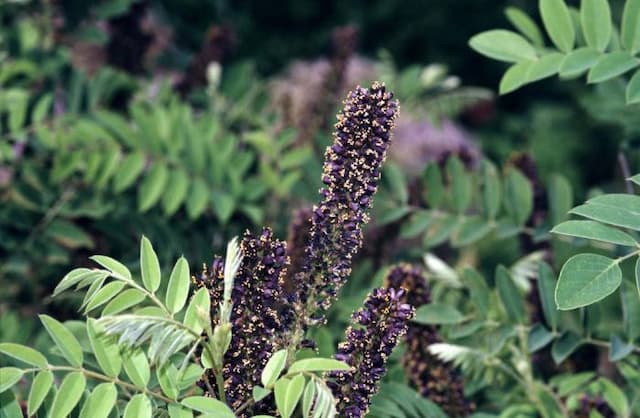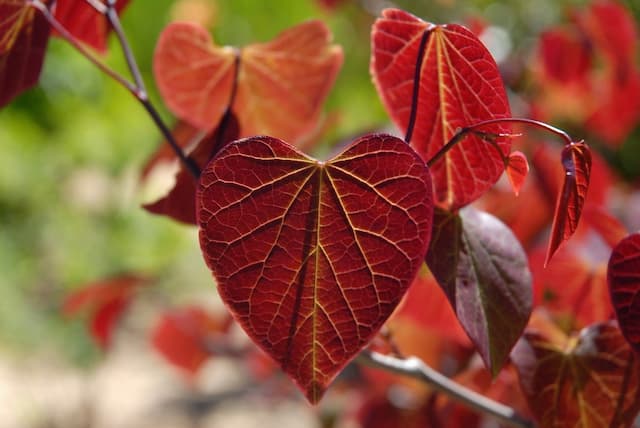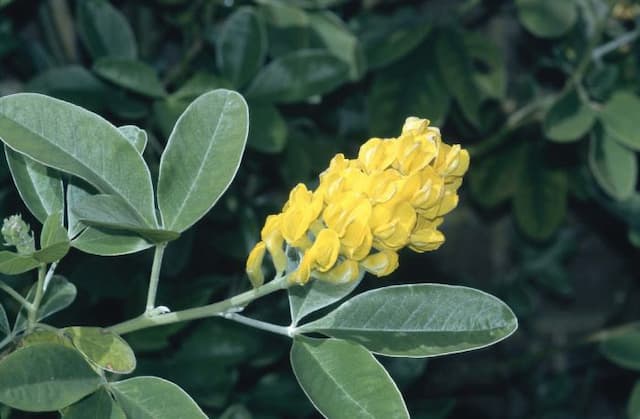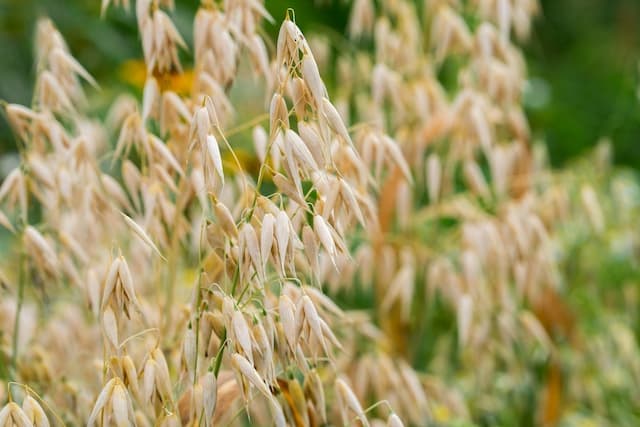Everlasting pea Lathyrus latifolius 'Rosa Perle'

ABOUT
The plant commonly known as the Everlasting Pea, Pearl Rose variety, boasts a beautiful display of flowers. These blossoms exhibit a soft pink color, reminiscent of freshwater pearls, hence the name 'Rosa Perle'. The petals have a delicate appearance with a typical pea-like shape, which includes a larger standard petal, two wing petals, and a keel made up of two smaller petals fused together. The foliage of the Everlasting Pea, Pearl Rose, consists of paired leaflets that are bright green in color, providing a lush background for the flowers. The leaflets are accompanied by tendrils that the plant uses to climb and support itself when growing near structures or other plants. These tendrils are thin and coiled, enabling them to grasp onto available supports. The Everlasting Pea, Pearl Rose, blooms in clusters, creating an attractive spray of color that can be quite eye-catching in the garden. The flowers form along a central stem, which stands out against the green foliage. After blooming, the flowers may give way to seed pods, which carry the potential for new growth in subsequent seasons. Overall, the Everlasting Pea, Pearl Rose, adds a touch of old-world charm to any garden with its romantic pink blossoms and graceful climbing habit. Its ability to provide long-lasting color and visual interest makes it a favored choice among gardeners who wish to incorporate vining plants into their landscapes.
About this plant
 Names
NamesFamily
Fabaceae.
Synonyms
Everlasting Pea, Perennial Pea, Broad-leaved Everlasting-pea, Eternal Pea, Hardy Sweet Pea.
Common names
Lathyrus latifolius 'Rosa Perle'.
 Toxicity
ToxicityTo humans
Everlasting pea, the common name of Lathyrus latifolius 'Rosa Perle', has potential toxicity to humans. While not commonly eaten, seeds and other plant parts contain a neurotoxic amino acid called ODAP or beta-N-oxalyl-L-a,alpha-diaminopropionic acid. Consumption in large quantities or over a prolonged period can cause lathyrism, a condition that can lead to paralysis and neurodegenerative disease. Symptoms of lathyrism include muscle weakness, decreased movement in the legs, and potentially permanent paralysis of the lower limbs.
To pets
Everlasting pea, the common name of Lathyrus latifolius 'Rosa Perle', can be toxic to pets. The seeds and possibly other parts of the plant contain a neurotoxic amino acid called ODAP or beta-N-oxalyl-L-a,alpha-diaminopropionic acid. Ingesting these can lead to a condition called lathyrism in animals, similar to that seen in humans. Symptoms in pets may include muscle weakness, difficulty walking, and potentially neurodegenerative changes that can result in paralysis, particularly affecting the hind legs.
 Characteristics
CharacteristicsLife cycle
Perennials
Foliage type
Deciduous
Color of leaves
Green
Flower color
Pink
Height
6 feet (1.8 meters)
Spread
3 feet (0.9 meters)
Plant type
Climber
Hardiness zones
4
Native area
Europe
Benefits
 General Benefits
General Benefits- Attractive Blooms: Lathyrus latifolius 'Rosa Perle', commonly known as everlasting pea, produces showy pink flowers that can enhance the aesthetics of gardens and landscapes.
- Drought Tolerance: Once established, everlasting pea is quite resilient to dry conditions, making it suitable for water-wise gardening.
- Erosion Control: The plant's extensive root system can help stabilize soil and prevent erosion on slopes or banks.
- Low Maintenance: Everlasting pea does not require frequent care beyond the initial planting and establishing phase, which makes it an easy plant for busy gardeners.
- Fast Growing: This vigorous climber can quickly cover trellises, fences, and other structures, providing rapid greenery and privacy.
- Long Flowering Season: Everlasting pea blooms for an extended period, often from early summer to early fall, providing long-lasting visual interest.
- Wildlife Attraction: The flowers can attract bees and other pollinators to the garden, benefiting the local ecosystem.
- Non-Invasive: Unlike its relative, the annual sweet pea, everlasting pea is non-invasive, so it's not likely to spread uncontrollably in the garden.
- Deer Resistant: The plant is relatively resistant to browsing by deer, making it suitable for areas where deer predation is a problem.
 Medical Properties
Medical PropertiesThis plant is not used for medical purposes.
 Air-purifying Qualities
Air-purifying QualitiesThis plant is not specifically known for air purifying qualities.
 Other Uses
Other Uses- Lathyrus latifolius, commonly known as perennial pea or everlasting pea, can be used in flower arrangements as a source of vibrant, long-lasting color.
- The dense foliage and climbing habit of the perennial pea make it a natural choice for covering unsightly fences or walls, lending a green facade to structures.
- Because of its rapid growth, perennial pea can be utilized in educational projects to demonstrate climbing plant behavior and growth patterns to students.
- The sturdy vines of the perennial pea can be trained on trellises or pergolas, adding a vertical element of beauty to gardens and outdoor spaces.
- Perennial pea plants can be used to stabilize soil on slopes or banks, preventing erosion with their extensive root systems.
- This plant can act as a ground cover in large garden areas, reducing weed growth due to its dense foliage.
- The perennial pea is sometimes included in butterfly gardens to attract pollinators with its colorful blooms.
- In rural areas, the perennial pea may be used as a living barrier for livestock, as the plants are not generally palatable to grazing animals.
- Photographers and artists may use the perennial pea as a picturesque backdrop for portrait sessions or still-life paintings because of its visual appeal.
- The seeds of perennial pea, contained in decorative pods, can be harvested and used for craft projects, although they should not be consumed as they can be toxic.
Interesting Facts
 Feng Shui
Feng ShuiThe Perennial Sweet Pea is not used in Feng Shui practice.
 Zodiac Sign Compitability
Zodiac Sign CompitabilityThe Perennial Sweet Pea is not used in astrology practice.
 Plant Symbolism
Plant Symbolism- Everlasting Affection - The common name of Lathyrus latifolius 'Rosa Perle' is perennial pea, and its enduring nature through multiple seasons symbolizes lasting love and affection that survives over time.
- Bliss and Pleasure - Perennial peas are often associated with the joy and bliss found in long-term companionship, reflecting the satisfaction and happiness of a deep bond.
- Departure - In the language of flowers, perennial peas can sometimes represent a farewell or an acknowledgment of a departure, possibly due to the plant's association with lasting farewells and memories.
- Thank You for Your Time - As a gift, the perennial pea may symbolize gratitude for someone's time or companionship, emphasizing appreciation for long-standing relationships.
 Water
WaterEverlasting pea 'Rosa Perle' requires consistent moisture, especially during the growing season. It should be watered deeply once or twice a week, allowing the soil to dry slightly between waterings. When watering, use about 1 gallon of water per plant to ensure that the moisture reaches deep into the root zone. During hot spells or dry periods, you might need to water more frequently, but always check the soil moisture first to avoid overwatering which can lead to root rot.
 Light
LightThe everlasting pea 'Rosa Perle' thrives in full sun to light shade. It prefers a spot that receives at least 6 hours of direct sunlight daily. If grown in too much shade, the plant may become leggy and produce fewer flowers. An ideal position would be in a sunny border or against a fence that receives ample sunlight.
 Temperature
TemperatureThe everlasting pea 'Rosa Perle' is hardy and can tolerate a range of temperatures, but it prefers temperate conditions. It can generally survive winter temperatures down to around 20°F and is comfortable in summer temperatures up to 85°F. The ideal temperature for robust growth and flowering is between 60°F and 70°F.
 Pruning
PruningPruning the everlasting pea 'Rosa Perle' helps to encourage healthy growth and improve air circulation. Prune in late winter or early spring before new growth begins, removing dead or weak stems. Cut back the plant by about a third to promote bushiness. Deadheading, or removing spent flowers, will also encourage more blooms.
 Cleaning
CleaningAs needed
 Soil
SoilEverlasting pea, 'Rosa Perle', thrives in loamy, well-draining soil with a pH ranging from 6.0 to 7.5. An ideal mix would be two parts garden soil, one part compost, and one part perlite or sand for drainage. Keep the soil moist, but not waterlogged.
 Repotting
RepottingEverlasting peas, like 'Rosa Perle', typically do not need frequent repotting and can do well for several years in the same pot. Check roots annually and repot every 2-3 years if pot-bound.
 Humidity & Misting
Humidity & MistingEverlasting pea, 'Rosa Perle', is tolerant of a range of humidity levels but performs best with moderate ambient humidity. It's not a humidity-dependent plant, so it can do well in normal outdoor conditions.
 Suitable locations
Suitable locationsIndoor
Place Everlasting pea in bright, indirect light.
Outdoor
Ensure full sun to part shade and moist soil.
Hardiness zone
4-8 USDA
 Life cycle
Life cycleLathyrus latifolius 'Rosa Perle', commonly known as the Everlasting Pea 'Rosa Perle', begins its life cycle as a seed planted in fertile, well-drained soil in early spring after the last frost. It quickly germinates, often in a few weeks, and seedlings emerge, developing into vigorous climbing vines with robust leaves. As the weather warms, the plant enters the vegetative stage, producing long tendrils that grasp onto supports and continue to grow throughout the spring and early summer. By midsummer, the plant reaches the flowering stage, displaying a profusion of attractive pink pea-like flowers that are highly ornate and continue blooming into early autumn. The flowers, following pollination, give way to seed pods that mature, eventually drying and releasing seeds for the next generation. Once the growing season concludes, the plant begins to senesce, dying back to the ground in regions with frost but may remain semi-evergreen in milder climates, ready to sprout again the following spring from overwintering rootstock.
 Propogation
PropogationPropogation time
Spring-Early Summer
The most popular method of propagating the perennial pea, known as Lathyrus latifolius 'Rosa Perle', is by seed. To propagate by seed, sow them directly into the ground where you want the plants to grow in early spring, as soon as the soil can be worked. Since perennial pea seeds have a hard outer coating, it is beneficial to scarify them by gently rubbing with sandpaper or nicking with a knife to improve water absorption and encourage germination. The seeds are then placed about 1 inch (2.54 cm) deep into soil-rich compost or well-draining soil, spaced around 2 to 3 inches (5.08 to 7.62 cm) apart. Germination can take from 2 to 4 weeks depending on the soil temperature. Once the seedlings are large enough to handle, they should be thinned out or transplanted to allow for proper growth and air circulation.









